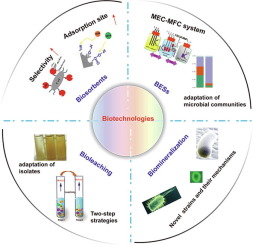当前位置:
X-MOL 学术
›
Bioresource Technol.
›
论文详情
Our official English website, www.x-mol.net, welcomes your feedback! (Note: you will need to create a separate account there.)
Recent advances in the recovery of metals from waste through biological processes.
Bioresource Technology ( IF 9.7 ) Pub Date : 2019-11-13 , DOI: 10.1016/j.biortech.2019.122416 Zhengsheng Yu 1 , Huawen Han 1 , Pengya Feng 1 , Shuai Zhao 1 , Tuoyu Zhou 1 , Apurva Kakade 1 , Saurabh Kulshrestha 2 , Sabahat Majeed 3 , Xiangkai Li 1
Bioresource Technology ( IF 9.7 ) Pub Date : 2019-11-13 , DOI: 10.1016/j.biortech.2019.122416 Zhengsheng Yu 1 , Huawen Han 1 , Pengya Feng 1 , Shuai Zhao 1 , Tuoyu Zhou 1 , Apurva Kakade 1 , Saurabh Kulshrestha 2 , Sabahat Majeed 3 , Xiangkai Li 1
Affiliation

|
Wastes containing critical metals are generated in various fields, such as energy and computer manufacturing. Metal-bearing wastes are considered as secondary sources of critical metals. The conventional physicochemical methods of metals recovery are energy-intensive and cause further pollution. Low-cost and eco-friendly technologies including biosorbents, bioelectrochemical systems (BESs), bioleaching, and biomineralization, have become alternatives in the recovery of critical metals. However, a relatively low recovery rate and selectivity severely hinder their large-scale applications. Researchers have expanded their focus to exploit novel strain resources and strategies to improve the biorecovery efficiency. The mechanisms and potential applicability of modified biological techniques for improving the recovery of critical metals need more attention. Hence, this review summarize and compare the strategies that have been developed for critical metals recovery, and provides useful insights for energy-efficient recovery of critical metals in future industrial applications.
中文翻译:

通过生物过程从废物中回收金属的最新进展。
包含关键金属的废物在能源和计算机制造等各个领域产生。含金属废物被认为是关键金属的次要来源。金属回收的常规物理化学方法消耗大量能源,并造成进一步的污染。低成本和环境友好的技术,包括生物吸附剂,生物电化学系统(BES),生物浸出和生物矿化,已成为关键金属回收的替代方法。但是,较低的回收率和选择性严重阻碍了它们的大规模应用。研究人员已将重点扩大到开发新型菌株资源和提高生物回收效率的策略。改进的生物技术用于提高关键金属的回收率的机制和潜在适用性需要更多关注。因此,本综述总结并比较了为关键金属的回收而开发的策略,并为未来工业应用中关键金属的节能回收提供了有用的见解。
更新日期:2019-11-13
中文翻译:

通过生物过程从废物中回收金属的最新进展。
包含关键金属的废物在能源和计算机制造等各个领域产生。含金属废物被认为是关键金属的次要来源。金属回收的常规物理化学方法消耗大量能源,并造成进一步的污染。低成本和环境友好的技术,包括生物吸附剂,生物电化学系统(BES),生物浸出和生物矿化,已成为关键金属回收的替代方法。但是,较低的回收率和选择性严重阻碍了它们的大规模应用。研究人员已将重点扩大到开发新型菌株资源和提高生物回收效率的策略。改进的生物技术用于提高关键金属的回收率的机制和潜在适用性需要更多关注。因此,本综述总结并比较了为关键金属的回收而开发的策略,并为未来工业应用中关键金属的节能回收提供了有用的见解。
















































 京公网安备 11010802027423号
京公网安备 11010802027423号